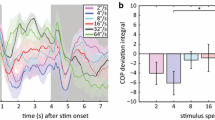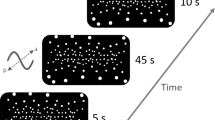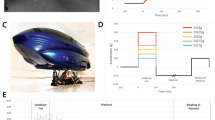Abstract
Optic flow simulating self-motion through the environment can induce postural adjustments in observers. Some studies investigating this phenomenon have used optic flow patterns increasing in speed from center to periphery, whereas others used optic flow patterns with a constant speed. However, altering the speed gradient of an optic flow stimulus changes the perceived rigidity of such a stimulus. Optic flow stimuli that are perceived as rigid can be expected to provide a stronger sensation of self-motion than non-rigid optic flow, and this may well be reflected in the amount of postural sway. The current study, therefore, examined, by manipulating the speed gradient, to what extent the rigidity of an optic flow stimulus influences posture along the anterior–posterior axis. We used radial random dot expanding or contracting optic flow patterns with three different speed profiles (single-speed, linear speed gradient or quadratic speed gradient) that differentially induce the sensation of self-motion. Interestingly, most postural sway was observed for the non-rigid single-speed optic flow pattern, which contained the least self-motion information of the three profiles. Moreover, we found an anisotropy in that contracting optic flow produced more postural sway than expanding optic flow. In addition, the amount of postural sway increased with increasing stimulus speed, but for contracting optic flow only. Taken together, the results of the current study support the view that visual and sensorimotor systems appear to be tailored toward compensating for rigid optic flow stimulation.









Similar content being viewed by others
Notes
A separate set of 8 observers were used for stimulus validation (see Table 1).
For stimulus validation, only two speeds (6 and 24 deg/s) were used.
References
Andersen GJ, Dyre BP (1989) Spatial orientation from optic flow in the central visual field. Percept Psychophys 45(4):453–458
Bronstein AM (1986) Suppression of visually evoked postural responses. Exp Brain Res 63(3):655–658
Bubka A, Bonato F, Palmisano S (2008) Expanding and contracting optic-flow patterns and vection. Perception 37(5):704–711
De Bruyn B, Orban GA (1990) The importance of velocity gradients in the perception of three-dimensional rigidity. Perception 19(1):21–27
Edwards M, Badcock DR (1993) Asymmetries in the sensitivity to motion in depth: a centripetal bias. Perception 22(9):1013–1023
Edwards M, Ibbotson MR (2007) Relative sensitivities to large-field optic-flow patterns varying in direction and speed. Perception 36(1):113–124
Edwards M, O’Mahony S, Ibbotson MR, Kohlhagen S (2010) Vestibular stimulation affects optic-flow sensitivity. Perception 39(10):1303–1310
Eklund G, Lofstedt L (1970) Biomechanical analysis of balance. Biomed Eng (NY) 5:333–337
Gibson JJ (1979) The ecological approach to visual perception. Houghton Mifflin, Boston
Gielen CCAM, van Asten WNJC (1990) Postural responses to simulated moving environments are not invariant for the direction of gaze. Exp Brain Res 79:167–174
Held R (1961) Exposure-history as a factor in maintaining stability of perception and coordination. J Nerv Ment Dis 132:26–32
Koenderink JJ (1986) Optic flow. Vision Res 26(1):161–180
Lee DN (1980) The optic flow field: the foundation of vision. Philos Trans R Soc Lond B Biol Sci 290:169–179
Lee DN, Aronson E (1974) Visual proprioceptive control of standing in human infants. Percept Psychophys 15(3):529–532
Lestienne F, Soechting J, Berthoz A (1977) Postural readjustments induced by linear motion of visual scenes. Exp Brain Res 28(3–4):363–384
Lishman JR, Lee DN (1973) The autonomy of visual kinaesthesis. Perception 2(3):287–294
Masson G, Mestre DR, Pailhous J (1995) Effects of the spatio-temporal structure of optical flow on postural readjustments in man. Exp Brain Res 103(1):137–150
Nakamura S (2010) Additional oscillation can facilitate visually induced self-motion perception: the effects of its coherence and amplitude gradient. Perception 39:320–329
Palmisano S, Pinniger GJ, Ash A, Steele JR (2009) Effects of simulated viewpoint jitter on visually induced postural sway. Perception 38(3):442–453
Palmisano S, Kim J, Freeman TC (2012) Horizontal fixation point oscillation and simulated viewpoint oscillation both increase vection in depth. J Vis 12(12):15. doi:10.1167/12.12.15
Peterka RJ, Benolken MS (1995) Role of somatosensory and vestibular cues in attenuating visually induced human postural sway. Exp Brain Res 105(1):101–110
Schiff W, Caviness JA, Gibson JJ (1962) Persistent fear responses in rhesus monkeys to the optical stimulus of “looming”. Science 136(3520):982–983
Shirai N, Birtles D, Wattam-Bell J, Yamaguchi MK, Kanazawa S, Atkinson J, Braddick O (2009) Asymmetrical cortical processing of radial expansion/contraction in infants and adults. Dev Sci 12(6):946–955. doi:10.1111/j.1467-7687.2009.00839.x
Stoffregen TA (1986) The role of optical velocity in the control of stance. Percept Psychophys 39(5):355–360
Todd J (1982) Visual information about rigid and nonrigid motion: a geometric analysis. J Exp Psychol Hum Percept Perform 8(2):238–252
Warren WH Jr, Hannon DJ (1988) Direction of self-motion is perceived from optical flow. Nature 336(6195):162–163
Wei K, Stevenson IH, Kording KP (2010) The uncertainty associated with visual flow fields and their influence on postural sway: Weber’s law suffices to explain the nonlinearity of vection. J Vis 10(14):4. doi:10.1167/10.14.4
Author information
Authors and Affiliations
Corresponding author
Electronic supplementary material
Below is the link to the electronic supplementary material.
Example movie of an expanding single-speed optic flow pattern containing a constant angular speed, resulting in the visual percept of which the center appears to move faster than the periphery. Note that the speed of the optic flow stimulus is different than in the experiment, since in the experiment the stimulus subtended 87° by 56°. (MPG 7762 kb)
Example movie of an expanding optic flow pattern containing a linear speed gradient, simulating the motion of a fronto-parallel plane toward the observer. Note that the speed of the optic flow stimulus is different than in the experiment, since in the experiment the stimulus subtended 87° by 56° (MPG 7442 kb)
Example movie of an expanding optic flow pattern containing a quadratic speed gradient, simulating observer movement through a circular tunnel. Note that the speed of the optic flow stimulus is different than in the experiment, since in the experiment the stimulus subtended 87° by 56° (MPG 6428 kb)
Rights and permissions
About this article
Cite this article
Holten, V., Donker, S.F., Verstraten, F.A.J. et al. Decreasing perceived optic flow rigidity increases postural sway. Exp Brain Res 228, 117–129 (2013). https://doi.org/10.1007/s00221-013-3543-z
Received:
Accepted:
Published:
Issue Date:
DOI: https://doi.org/10.1007/s00221-013-3543-z




